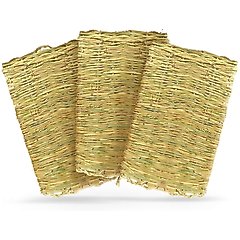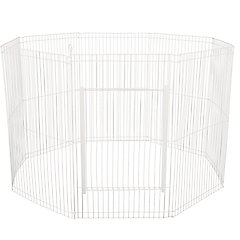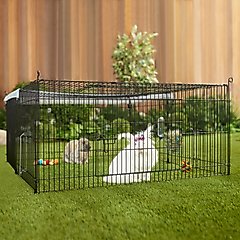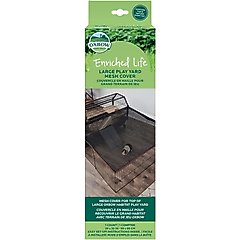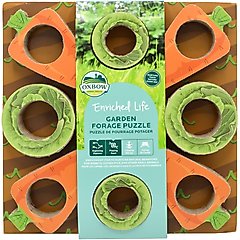Bunny Playtime: Can I Take My Pet Rabbit Outdoors?

Photo by libin jose/iStock/Getty Images Plus
While bunnies should only be housed indoors, you can allow your pet rabbit some outdoor time to enjoy the different sights, sounds, and smells in your yard.
With close supervision and a proper setup, playtime for bunnies outside can be fun and enriching for your furry friend.
Key Takeaways
- Rabbits should live indoors, but short, supervised sessions outside can offer mental stimulation, exercise, and confidence boosts.
- Bunny outside playtime can pose serious risks, like heat, predators, pesticides, toxic plants, and disease.
- A secure, enclosed playpen in the shade is essential, along with uninterrupted supervision.
- Watch your rabbit closely for signs of anxiety, like fast breathing, pinned ears, freezing, or refusal to eat. If your rabbit seems stressed, keep playtime indoors.
- Provide covered shelter and shade, and offer toys like tunnels and puzzle feeders to keep your bunny happy and stimulated.
Why Your Yard Is Dangerous for Pet Rabbits
The outdoors can be extremely unpredictable and dangerous for bunnies, since they’re prey animals.
Heat
Rabbits are very sensitive to temperature. It should always be warmer than 50 F, but anything above 75 to 80 degrees is too hot for any rabbit, says Christine Austin, DVM, shelter veterinarian at House Rabbit Society, in Richmond, California.
“Rabbits can succumb to heatstroke easily, so it’s of utmost importance to monitor temperatures as it gets warmer,” she explains.
Your rabbit also needs shade from the sun (even if it’s not very hot). You should also set up a barrier from breezy weather or windchill—even in ideal temperatures.
Your rabbit always needs access to fresh, clean water. Try a ceramic bowl that won’t easily flip over.
Recommended Product
Predators
Rabbits have many natural predators, Dr. Austin says. These include coyotes, raccoons, foxes, hawks, and other birds of prey, as well as pets, like dogs, cats, and ferrets.
Hawks are especially dangerous, as they can swoop down and take a rabbit—even when a pet parent is supervising. That’s why it’s crucial to have a secure covering over the top of any play area and monitor your rabbit at all times when they’re outside, Dr. Austin says.
Toxic Plants
In the midst of frolicking outdoors, your bunny may encounter plants and flowers. Naturally, your little herbivore may be keen on trying to chew these. But it’s important to know which plants are OK and which are dangerous.
According to the Merck Veterinary Manual, plants and flowers that are harmful to rabbits include:
- Aloe
- Azalea
- Calla lily
- Carnation
- Lily of the valley
- Philodendron
Pesticides
Pesticides and fertilizers on grass are extremely dangerous to rabbits.
Avoid letting your rabbit eat or play on grass treated with pesticides, herbicides, or synthetic fertilizers, since they can cause acute poisoning or chronic issues, like skin burns on their sensitive paws, says Sabrina Kong, DVM, a veterinary consultant at We Love Doodles in San Mateo, California.
She also considers “weed and feed” products risky since rabbits could ingest toxins while grooming contaminated fur.
If you’re not sure if the grass has been free of pesticides for at least six months, avoid it to be safe.
Safer alternatives include growing organic wheatgrass pots indoors or using untreated hay mats to line their playpen.
Recommended Products
Diseases
Another potential risk is disease, Dr. Austin says. One of the most serious is RHDV, which affects both domestic and wild rabbits and can be fatal.
Fortunately, there’s a safe, effective vaccination for it. Dr. Austin recommends all rabbits—even indoor-only rabbits—be vaccinated.
Fleas and ticks are also a concern, and microscopic parasites in soil can also pose a health hazard.
How To Help Your Rabbit Play Safely Outside
Think your rabbit would still have a blast outside? Here’s how to make it happen—with constant supervision, of course.
Choose the Right Outdoor Playpen or Hutch
Set up your rabbit’s outdoor play area with their safety and comfort in mind:
- Secure all sides of the play area. Rabbits can easily dig under a fence or barrier—they can easily squeeze through and escape too. Choose galvanized steel, hardware cloth (¼-inch grid) for the sides and a solid base, like plywood covered in fleece, Dr. Kong says. Check that all edges are smooth and buried at least 6 inches underground to prevent digging escapes or predator access.
- Place a secure cover over the play area. You can use PVC-coated wire to shield against birds. Not only does this help prevent predation by birds of prey, but it also helps prevent rabbits from jumping out.
- Avoid certain materials. Steer clear of chicken wire, or hexagonal mesh, since this can trap a rabbit’s heads or limbs. Also avoid wire floors or gaps wider than 1 inch.
- Always supervise. Rabbits should be supervised when they’re outdoors. This ensures they are safe at all times.
A large, portable playpen that’s at least 4 feet by 4 feet is vastly superior for activity. Playpens give rabbits plenty of space to run, binky, and explore, which is essential for their daily exercise and enrichment needs.
Recommended Products
Pick a Secure, Shady Spot
A rabbit’s play area should be far away from dangers like poisonous plants. Secure it to prevent them escaping—and any potential predators from making their way in.
Place it either on untreated grass or a soft surface, like a fleece blanket or the Oxbow leakproof floor cover, since hard surfaces like concrete can be hard on their delicate feet.
Recommended Products
Your rabbit also needs a spot in the shade, not direct sunlight, to keep cool.
Give Your Rabbit Fun Outdoor Toys
Rabbits also require mental stimulation. Some binky-worthy enrichment ideas include:
- Tunnels and unprocessed cardboard playhouses that give them places to chew, hide, or explore, like the Bunny Bliss bunny playhouse and hideaway
- Puzzle feeders and snuffle mats to encourage foraging, such as the Oxbow Enriched Life garden forage puzzle
- Dig boxes, ball pits, and burrow boxes that give them appropriate places to dig, like the Oxbow Enriched Life garden dig box (which is also great for your rabbit’s teeth!)
You can also stuff their toys with hay or their favorite treats for even more mental stimulation.
Recommended Products
Do All Rabbits Enjoy Outdoor Playtime?
Not all bunnies like to be outside, so you shouldn’t force your rabbit to enjoy it.
“A lot of house rabbits find the outdoors overwhelming and terrifying,” Dr. Austin says. “This can be worse in loud areas or spaces where there are not appropriate hiding spots.”
If a rabbit tends to be on the shy side or hides when they hear a loud noise, it might be best to keep them indoors.
To gauge whether your rabbit enjoys being outside, start with 5 to 10 minutes of supervised sessions in a fully enclosed exercise pen on untreated grass (or another soft area), Dr. Kong says.
She recommends bringing their favorite greens to create positive associations and watching closely for relaxed body language, like curious nose-twitching, perked ears, and confident hopping.
Monitor for any signs of stress when your rabbit is outdoors, such as:
- Fast breathing or changes in breathing
- Ears pinned back
- Sitting in a hunched ball
- Being excessively watchful
- Freezing
- Scaring more easily
- Not willing to eat
- Frantic scratching at the pen
If your rabbit is feeling stressed, place them in their normal habitat and bring the fun indoors. Some bunnies prefer to live their best life inside—and that’s perfectly OK!
FAQs About Taking a Bunny Outside
Is it OK to keep rabbits outside?
No, pet rabbits shouldn’t live outside. They’re very sensitive to hot and cold temperatures, and they’re easy prey. “This is why indoor rabbits typically live 8 to 12 years, double the lifespan of outdoor-housed rabbits,” Dr. Kong adds.
Can you leash-train a rabbit?
Yes, you can leash-train a rabbit as long as you use secure a rabbit-specific harness and leash. But make sure your rabbit enjoys being outside; otherwise, keep them indoors.
Can my rabbit free-roam outside?
No, rabbits shouldn’t free-roam outside. It’s exceptionally risky and rare that they would find their way home if they escape.
Can outdoor time boost your bunny’s health?
Yes, supervised time outdoors can be beneficial for rabbits who enjoy the outdoors. It can offer extra enrichment and mental stimulation, which can reduce stress hormones and prevent stereotypic behaviors, like overgrooming.

